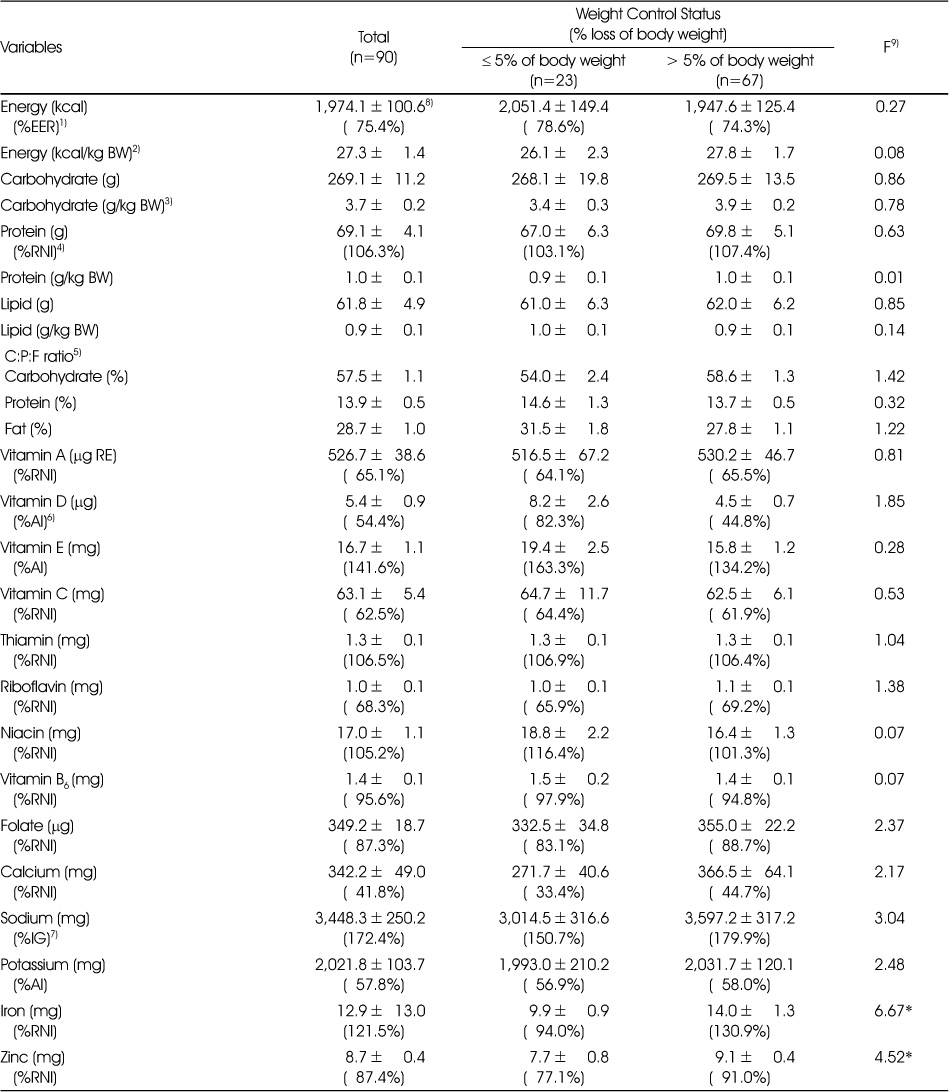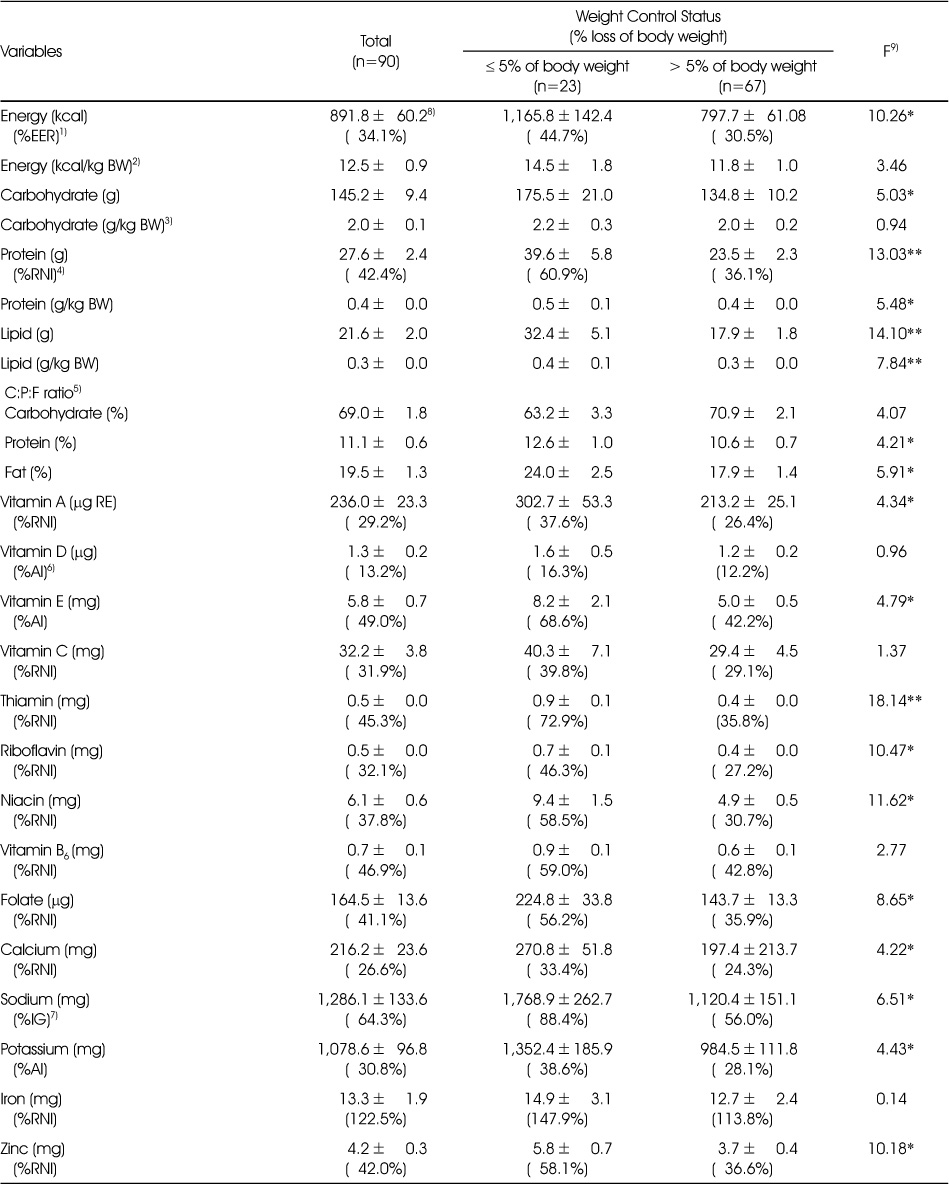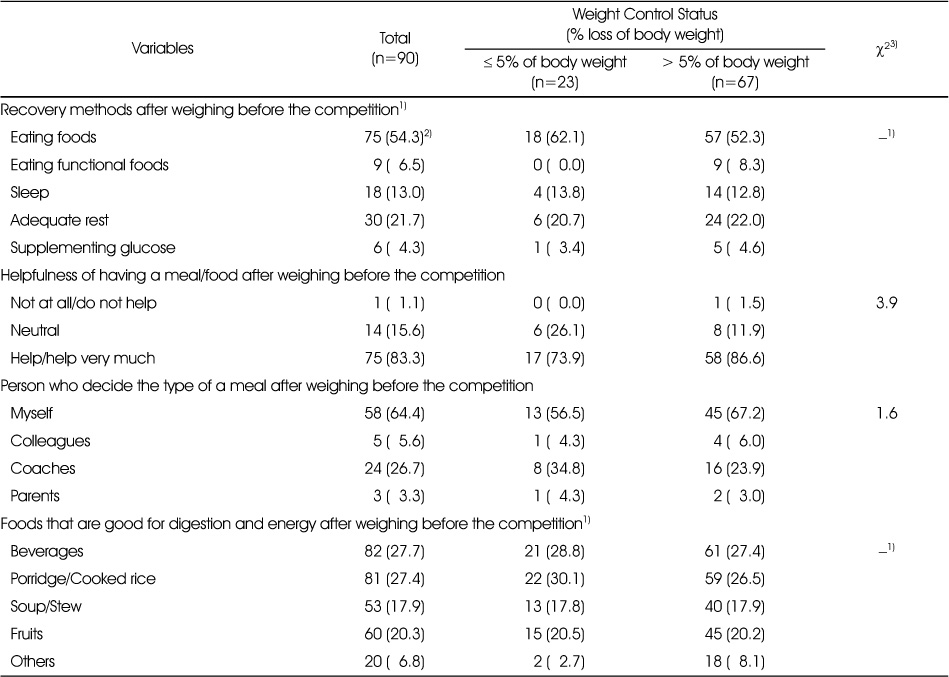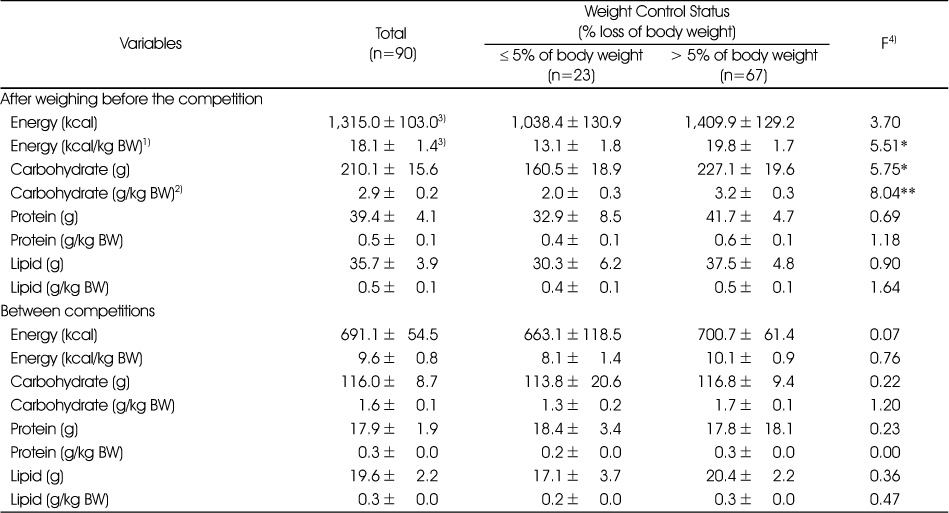Articles
- Page Path
- HOME > Korean J Community Nutr > Volume 22(6); 2017 > Article
-
Research Article
- Nutrient Intakes of Male College Combat Sport Athletes by Weight Control Status
-
Ji Yeon Kim, Ji Seon Lee, Seong Suk Cho, Hyon Park, Kyung Won Kim

-
Korean Journal of Community Nutrition 2017;22(6):495-506.
DOI: https://doi.org/10.5720/kjcn.2017.22.6.495
Published online: December 31, 2017
Food and Nutrition, Seoul Women's University, Seoul, Korea.
1National Training Center of Korea Olympic Committee, Seoul, Korea.
2Sports Medicine, Kyung Hee University, Yongin, Korea.
- Corresponding author: Kyung Won Kim. Food and Nutrition, College of Natural Sciences, Seoul Women's University, 621 Hwarang-ro, Nowon-gu, Seoul 01797, Korea. Tel: (02) 970-5647, Fax: (02) 976-4049, kwkim@swu.ac.kr
Copyright © 2017 The Korean Society of Community Nutrition
This is an Open-Access article distributed under the terms of the Creative Commons Attribution Non-Commercial License (http://creativecommons.org/licenses/by-nc/3.0/) which permits unrestricted non-commercial use, distribution, and reproduction in any medium, provided the original work is properly cited.
- 1,182 Views
- 6 Download
- 1 Crossref
Figure & Data
REFERENCES
Citations

- Weight control practices, beliefs, self-efficacy, and eating behaviors in college weight class athletes
Ji Seon Lee, Seong Suk Cho, Kyung Won Kim
Nutrition Research and Practice.2020; 14(1): 45. CrossRef
General characteristics of the study subjects
*: P<0.05, **: P<0.01, ***: P<0.001
1) Mean±SE, 2) n (%), 3) t value by t-test or χ2 value by χ2-test
Energy and nutrients intakes during training period by the weight control status
*: P<0.05
1) Estimated Energy Requirements, 2) kcal/kg body weight, 3) g/kg body weight, 4) Recommended Nutrient Intake, 5) Ratio of energy intake, 6) Adequate Intake, 7) Intake Goal, 8) Mean±SE, 9) F value by analysis of covariance (covariate: weight, height). For variables analyzed by kg/body weight, only height was used as a covariate.
Energy and nutrients Intakes during weight control period by the weight control status
*: P<0.05, **: P<0.01
1) Estimated Energy Requirements, 2) kcal/kg body weight, 3) g/kg body weight, 4) Recommended Nutrient Intake, 5) Ratio of energy intake, 6) Adequate Intake, 7) Intake Goal, 8) Mean±SE, 9) F value by analysis of covariance (covariate: weight, height). For variables analyzed by kg/body weight, only height was used as a covariate.
Meal management during the period after weighing before the competition
1) Multiple response, 2) n (%), 3) χ2 value by Fisher's exact test
Intakes of energy and energy-yielding nutrients during periods after weighing before the competition and between competitions
*: P<0.05, **: P<0.01
1) kcal/kg body weight, 2) g/kg body weight, 3) Mean±SE, 4) F value by analysis of covariance. (covariate: weight, height)
*: P<0.05, **: P<0.01, ***: P<0.001 1) Mean±SE, 2) n (%), 3) t value by t-test or χ2 value by χ2-test
*: P<0.05 1) Estimated Energy Requirements, 2) kcal/kg body weight, 3) g/kg body weight, 4) Recommended Nutrient Intake, 5) Ratio of energy intake, 6) Adequate Intake, 7) Intake Goal, 8) Mean±SE, 9) F value by analysis of covariance (covariate: weight, height). For variables analyzed by kg/body weight, only height was used as a covariate.
*: P<0.05, **: P<0.01 1) Estimated Energy Requirements, 2) kcal/kg body weight, 3) g/kg body weight, 4) Recommended Nutrient Intake, 5) Ratio of energy intake, 6) Adequate Intake, 7) Intake Goal, 8) Mean±SE, 9) F value by analysis of covariance (covariate: weight, height). For variables analyzed by kg/body weight, only height was used as a covariate.
1) Multiple response, 2) n (%), 3) χ2 value by Fisher's exact test
*: P<0.05, **: P<0.01 1) kcal/kg body weight, 2) g/kg body weight, 3) Mean±SE, 4) F value by analysis of covariance. (covariate: weight, height)

 KSCN
KSCN





 Cite
Cite


